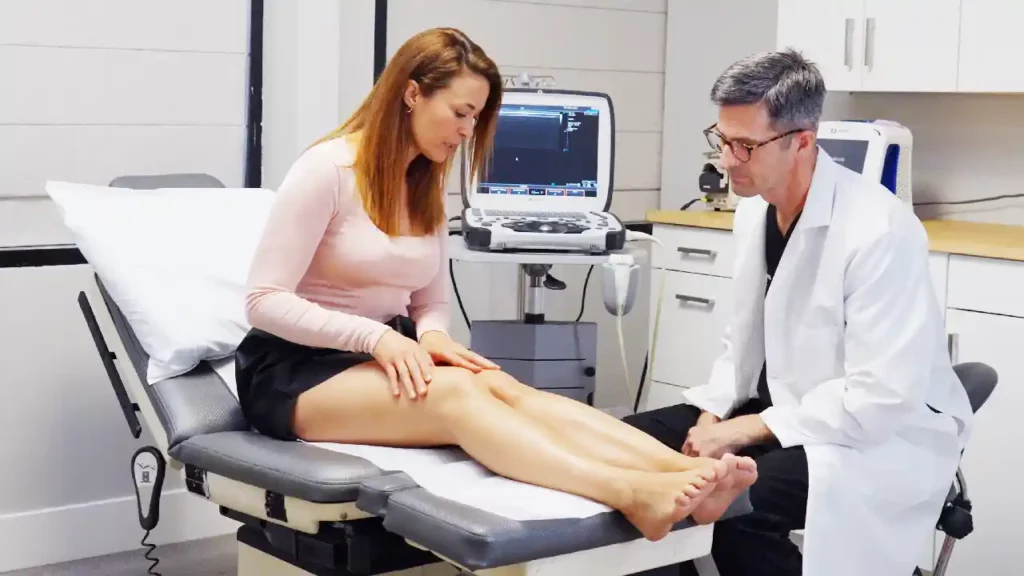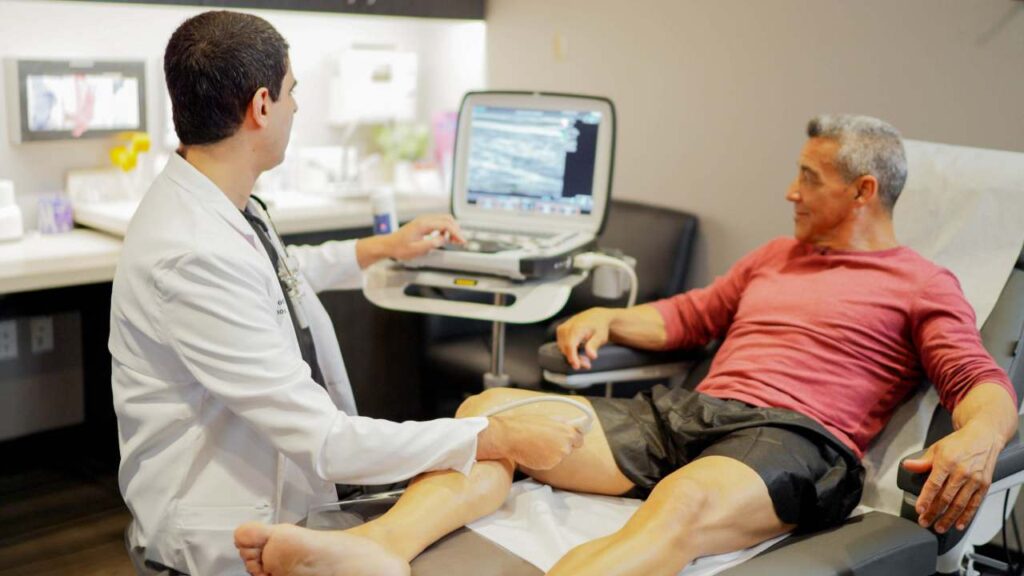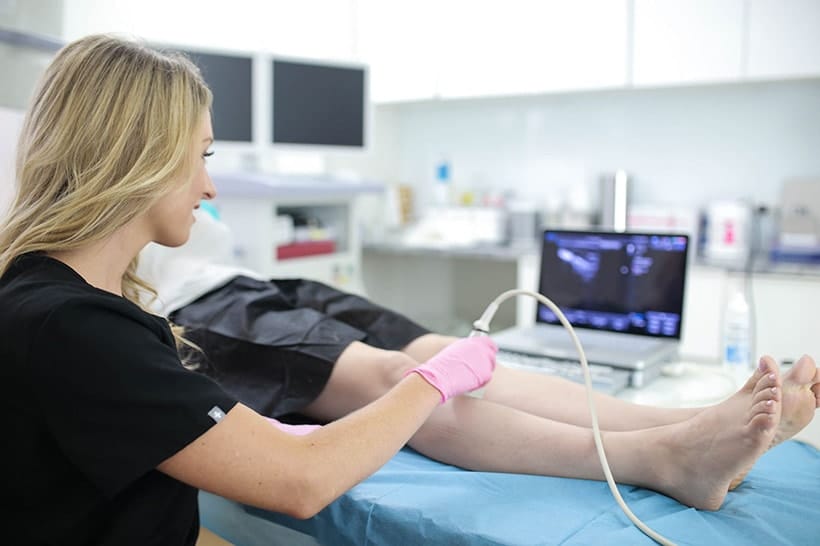What to Expect at Your Initial Consultation
Your initial consultation includes a review of your medical history and a discussion of your symptoms and concerns. The vein doctor will conduct a physical exam to identify problematic veins and what might be causing them. If needed, they’ll perform additional tests, such as lab work, ultrasounds, or vein mapping. Book an appointment with our Harvard-trained vein doctors for a confident diagnosis and a reassuring experience. Our vein doctors are as renowned for their treatments as they are for their compassionate care.
Unlike other medical appointments, you won’t feel rushed at our California vein centers. Our vein specialists enjoy explaining vein issues and treatments that resolve them. We won’t conclude your appointment until all of your questions are answered. We’re also easy to communicate with if you think of more questions after you leave. These initial consultations can be as short as 15 minutes, or as long as you need them to be, to feel satisfied with your diagnosis and treatment plan. Our vein doctors create a personalized treatment plan for each patient. We look forward to discussing your options with you.

What to Expect with Spider Vein Treatments in California
Spider veins are quick and easy to treat with the latest methods. Most patients will receive sclerotherapy for spider veins. It’s a fast, painless injection of a sclerosing solution that irritates the vein’s walls, which causes them to close. Sclerotherapy comes in liquid, foam, and pre-mixed foam concentrations. The right one depends on the size and severity of the vein. Some patients have surface laser treatments for spider veins instead. But lasers can irritate sensitive skin, especially in people with skin conditions. That’s why sclerotherapy is considered the first line of treatment for most small spider veins. If you have large spider veins or varicose veins, you might need one of the treatments described in the next section.
What to Expect with Varicose Vein Treatments in California
Most spider and varicose veins are now treated with minimally invasive procedures rather than surgery. Surgical vein stripping is reserved for a small percentage of patients with blood clots or extreme tortuosity which makes the vein unnavigable for treatment devices. If you’re having a minimally invasive procedure, it’s an easy process. There is no pre-procedural prep, in terms of eating or drinking, since these treatments don’t use general anesthesia.
You might need to stop taking certain medications prior to treatment, but your doctor will advise you about that. You don’t need to arrive early since you won’t be put to sleep. Most patients can wear their own clothing (depending on the location of the vein). Loose clothing is recommended if the doctor will need to move the pant leg or sleeve to access the vein. Here’s how some of our most common procedures work.
- Sclerotherapy: No anesthesia is required. The vein doctor cleanses the skin above the treated vein and applies a topical numbing cream if needed. Then, they’ll insert a small needle into the blood vessel and inject a sclerosing solution into the vein to close it.
- Mechanochemical Ablation: This procedure is similar to sclerotherapy, but it’s a dual approach. The vein doctor inserts a rotating catheter into the vein. They inject a sclerosing solution and also rotate the catheter. Both tactics intentionally irritate the vein walls, causing the vein to close. This technique does not require anesthesia. Doctors often employ ultrasound guidance to observe the treatment.
- Radiofrequency Ablation: The vein doctor cleanses the area and inserts a tiny, hollow catheter into the vein. They inject local anesthetic around the vein to protect the surrounding area from heat. Then, they thread a fiber through the catheter which they activate with soundwaves to heat the vein. Once the vein is heated, the process is complete. Doctors often use ultrasound guidance for this procedure.
- Vein Adhesives: Like sclerotherapy and mechanochemical ablation, this procedure does not utilize heat. So, local anesthesia isn’t required. Doctors simply inject cyanoacrylate glue into the vein to seal it shut. They might apply pressure to direct the adhesive throughout the vein. They might also utilize ultrasound imaging.
What to Expect at the Injection Site or Treated Area
Many patients will have no discomfort or irritation at the injection site. But it’s normal to have a little redness, soreness, or bruising near the treated area for a day or two. Patients with sensitive skin and those who bruise easily are more prone to these reactions. If you develop streaks of redness, itching, or oozing, consult your doctor about an infection. If you notice a sudden area of redness, warmth, and swelling, call the doctor immediately to rule out a blood clot. If you have chest pain or trouble breathing, head to the emergency room. Severe reactions are exceedingly rare. Most patients have negligible symptoms after vein treatment. But, as with any medical procedure, don’t ignore red flags.
What to Expect If You Wear Compression Stockings Afterward
Some patients need to wear compression stockings after vein treatment to encourage blood flow. It’s usually only for a few days, and many patients don’t need them at all. Compression therapy won’t prohibit you from exercising or resuming normal routines if your doctor approves. You can remove compression stockings for bathing and showering. Do not wear compression stockings before or after vein treatment without a vein doctor’s recommendation. They aren’t safe for everyone, and they need to be sized by a doctor to prevent insufficient or excessive compression. Some patients with varicose veins develop skin conditions, including venous ulcerations and venous stasis dermatitis, which could be irritated by compression stockings. Always ask your doctor first.
What to Expect During Spider and Varicose Vein Recovery
Non-surgical recovery from spider and varicose vein treatment is pleasantly easy. Patients can walk right after the procedure. Many people drive themselves home and resume their typical activities, including moderate exercise. Most treatments take 15 to 30 minutes, and patients can leave promptly since they don’t have to recover from anesthesia. Bathing, showering, and swimming are permitted with the least invasive methods. There are no large wounds to care for. Modern vein treatment is so innovative and gentle that many of our patients seek treatment during their lunch break and go back to work. Visit our state-of-the-art San Diego vein center near Mira Mesa Chiropractic or our cutting-edge San José or Palo Alto centers to learn more!






